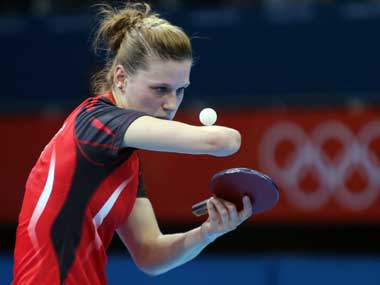by Avirook Sen Here is a little exercise you could try at home. Balance a ping-pong in the fold of your elbow and try and toss it up a few inches. Now, with your free hand, try and hit the ball with a racket so that it lands roughly in the area you’re aiming at. For those of us fortunate enough to have tuned into the coverage of the Olympics at around 11 pm (India time) on Sunday, an exceptional athlete called Natalia Partyka demonstrated how this is done to near perfection. Partyka is a 23-year-old Pole who was born without her right hand and forearm. Her elbow ends in a stump. She is one of a handful of athletes to compete in both the Paralympics and the celebrated ‘open’ event now taking place in London. She competed in Beijing as well. [caption id=“attachment_396140” align=“alignleft” width=“380”]  Polish Natalia Partyka, 23, was born without her right hand and forearm. Her elbow ends in a stump. She is one of a handful of athletes to compete in both the Paralympics and the ‘open’ event. Sergei Grits/AP[/caption] It is of little consequence that she lost her third round table tennis match. What is more important is that you could not take your eyes off her. In table-tennis, the serve is possibly the most important stroke, and therefore has the most stringent rules attached. You must, for instance, ‘show’ the ball clearly (it rests, usually, on an open palm) to the opponent and umpire as you prepare to serve. You cannot impart spin with your hands, and must toss it a little over six inches near vertically. Under table-tennis’ modern rules, the serve changes every two points. Every two points, through six hard-fought games, Partyka, went about her routine. She placed the ball on the stump on her right arm, let it roll off, bounce a few times on the table, replaced it in one motion. Then, she tossed and served, her racket ready to answer any weak returns with vicious top-spin drives. It was awe-inspiring. It was what the Olympics are about. Moments such as these are rare, even in the Olympics. Yet sometimes, they can get overshadowed. If you ask people what they know about the gymnastic events in Montreal, 1976, the standard reply would be Nadia Comaneci; perfect 10. Comaneci’s feat was historic — a first no one thought was possible. But how about a 9.7 with a broken knee? That happened in Montreal too. The Japanese gymnast Shun Fujimoto had injured himself badly during the floor exercises. He should have played no further part in the Games. But were he to withdraw, Japan would lose gold in the team event. How he convinced his coaches we will never know, but Fujimoto competed in the two disciplines remaining. In the last — the rings, an apparatus that demands superhuman fitness and strength in the first place — he was helped up to get a grip like every other gymnast; on his way down, he was on his own. With a broken knee-cap, Fujimoto completed his twisting double-back dismount — he would have heard the sickening sound of grating broken bones as he landed. You could tell that from his expression, as he hobbled to stay upright. There are few images I have seen that are as moving as the video of that routine. You know what the gymnast knows as the dismount approaches. It will be the end of the routine, but the beginning of unbearable pain. Every swing and somersault is just a prelude to that unalterable fate. And yet, Fujimoto decides to go through with it. It is easy to place people like Partyka and Fujimoto in the silos labeled with their ‘national character’. The Poles, have a history of rising against occupying powers, fighting odds. Their national anthem begins with the words “Poland is not perished yet/So long as we still live…” A missing limb is no reason to give up the fight. The Japanese values of honour and sacrifice are well known. Fujimoto’s performance could be seen through the lens of Japanese culture, and indeed he is an iconic figure in his own country for embodying Japan’s loftiest values. But these categorisations are a little too convenient, and sometimes plain invalid. For instance, Partyka’s opponent on Sunday was a Dutch athlete of Chinese descent. How would one label her? Those in the habit of memorising medal tallies (or marketing the event to a specific audience — “I am an Olympian, but first, I am an Indian” and so on) might look it that way, but the Olympics are not about showcasing ‘national character’. They provide a grand stage where the strength of the human will is tested. Every once in a while, through the performances of people like Partyka and Fujimoto, we get a glimpse of that strength. And it is awesome. That is what the Olympics are about.
The media is obsessed with the medal hunt but the Olympics are not about national medal tallies. The one-armed table-tennis player, the gymnast with the broken knee - these moments make the Games superhuman.
Advertisement
End of Article
Written by FP Archives
see more


)

)
)
)
)
)
)
)
)



